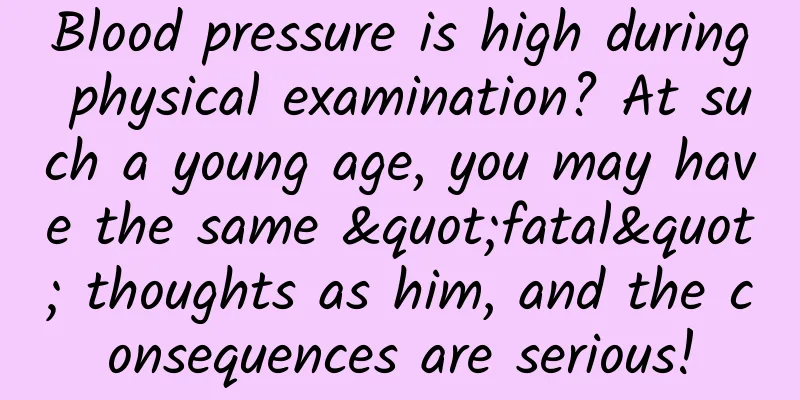Blood pressure is high during physical examination? At such a young age, you may have the same "fatal" thoughts as him, and the consequences are serious!

|
Xiao Li is 38 years old this year, in the prime of his life, and his career is booming. The dual pressures of life and work did not make this young man hesitate, but instead inspired him to face challenges without fear, which also made him full of infinite possibilities and expectations for his future life. Of course, Xiao Li's daring character also stems from his confidence in his physical fitness. However, behind this confidence, there is actually a bit of guilt - in recent years, physical examinations have found that his blood pressure has been high . Although he is very familiar with the three words "high blood pressure", Xiao Li is not sure what the normal blood pressure should be. Later, he checked it online and found that it was only a little higher than the normal value after comparison. What's more, he didn't feel any special symptoms of discomfort, and it didn't affect his normal life and work, so he didn't take it seriously at all . But in the past three years, Xiao Li's blood pressure was still high during physical examinations. Due to the nature of his job, he is usually busy and staying up late to work overtime is commonplace. During this time, he occasionally feels dizzy and chest tightness. Sometimes when he sees news reports of various sudden deaths and the various dangers of high blood pressure, he can't help but think of himself. Only then did he start to take it seriously and wanted to go to the hospital for a good check-up. When he went to see the doctor, Xiao Li looked tired and did not have the energy and spirit that a young person should have. The doctor prescribed a series of tests for Xiao Li and found that Xiao Li had no other diseases. Therefore, the doctor ruled out the possibility of secondary hypertension, that is, the symptoms of hypertension caused by other underlying diseases. After a detailed interview with Xiao Li, the doctor learned that both of Xiao Li's parents suffered from hypertension , so he judged that Xiao Li's hypertension might be caused by the interaction of family genetic susceptibility and environmental factors, which is what we often call hypertension. After learning the result, Xiao Li sighed. In his words, it was unexpected but also reasonable. At first, he had no symptoms and did not think about it. Besides, it did not affect his normal life and work, so he did not take it seriously. The doctor sternly rebuked: "Most young patients rely on their youth and the fact that they don't feel any discomfort. Even if the physical examination shows a blood pressure problem, they don't take it seriously and always think it is a disease that the elderly should have. Let's take a look at the following data: First, in China, hypertension is not only the chronic non-communicable disease with the largest number of patients, but also the primary and modifiable risk factor for increased risk of cardiovascular disease and mortality . Second, the number of adult patients with hypertension is about 245 million , and on average, 3 out of every 10 adults are "targeted" by it. Unfortunately, less than 2 out of 10 hypertensive patients can control their blood pressure within the normal range, and the rest have not paid attention to it, allowing the soaring blood pressure to invade the body. Third, the overall awareness, treatment and control rates of hypertension in China are still at a low level, and about 49.4% of hypertensive patients do not know that they have hypertension . In other words, nearly half of hypertensive patients do not know that they have a disease that needs treatment. Faced with such a common chronic disease, do you still think it is far from young people? Why do most people not know that they have high blood pressure, and even if they know, they do not take active measures to treat it? All this stems from the invisible nature of high blood pressure . On the one hand, most of the early symptoms of high blood pressure are asymptomatic or not obvious, which makes us unaware; on the other hand, many people think that there is no serious harm in the short term, so they feel that there is no need for treatment. But it relies on its unique concealment to destroy you little by little under our consistent thinking and wrong cognition. The most important pathological changes of high blood pressure occur in the small arteries throughout the body. Simply put, the small arteries generally have thickened walls, narrowed lumens, lost elasticity, and increased resistance due to various reasons. Normal pressure cannot allow blood to pass normally, and pressure must be increased, and blood pressure rises. Abnormally high blood pressure is extremely destructive to various organs throughout the body. The key is that these changes are qualitative changes and are irreversible. Once obvious symptoms of high blood pressure appear, the best time to control high blood pressure may have been missed, which will lead to cardiovascular and cerebrovascular diseases, or will be accompanied by fatal diseases such as sudden heart disease, heart failure, stroke, and renal failure. In addition, high blood pressure has a clear genetic tendency , which makes it difficult to prevent. The susceptibility to high blood pressure depends largely on the individual's genetic basis. Studies have found that if both parents suffer from high blood pressure, the probability of their children suffering from high blood pressure in the future is as high as 45%; if one parent suffers from high blood pressure, the probability of their children suffering from high blood pressure is 28%; and if both parents have normal blood pressure, the probability of their children suffering from high blood pressure is only 3%. Therefore, people with a family history of high blood pressure should pay more attention to the development of a healthy lifestyle, improve their awareness of prevention, and do a good job of regular dynamic blood pressure monitoring to achieve early detection, early intervention, and early treatment. " Xiao Li: "This invisible characteristic makes high blood pressure so cunning, and even has the influence of genetic factors, which is inevitable. Does this mean that I have to accept the fate of suffering from high blood pressure?" The doctor explained: "In fact, after years of exploration and practice, the diagnosis, treatment and management of hypertension have gradually matured. The management of hypertension has also been given "new era characteristics." It takes a long time to go from normal blood pressure to pre-hypertension, then to hypertension, and finally to trigger various complications. This makes it possible for us to actively prevent, treat and control hypertension, delay the occurrence and development of complications, and buy more time. Fighting hypertension is not to completely eliminate it, but to be prepared for a protracted war. On November 13, 2022, the first "Chinese Hypertension Clinical Practice Guidelines" (hereinafter referred to as "Guidelines") jointly formulated by the National Center for Cardiovascular Diseases, the Chinese Medical Association and other professional committees was released. Among them, detailed evidence-based recommendations are given for diagnosis, evaluation and treatment in the field of hypertension, aiming to comprehensively improve the diagnosis and treatment of hypertension in my country through evidence-based guidance of clinical practice. The guidelines clearly state that by combining a patient's combined cardiovascular risk factors, combined diseases, and determining whether the patient is at high risk for cardiovascular disease, one can directly determine the timing of treatment and achieve ideal treatment expectations. Patients with systolic blood pressure (SBP) ≥140 mmHg and/or diastolic blood pressure (DBP) ≥90 mmHg, and those with SBP130-139 mmHg and/or DBP80-89 mmHg accompanied by clinical comorbidities, target organ damage, or ≥3 cardiovascular risk factors will be directly classified as high-risk patients and require drug-induced blood pressure management. For patients with SBP130~139 mmHg and/or DBP80~89 mmHg, accompanied by 0~2 cardiovascular risk factors, they are not in the high-risk group and can undergo 3~6 months of lifestyle intervention, such as controlling weight and waist circumference, and increasing exercise. If non-drug treatment for more than 3 to 6 months is ineffective, it is necessary to consider initiating drug treatment as soon as possible according to the doctor's advice. The guidelines also point out: According to the latest international guidelines for initiating antihypertensive drug treatment, among adults aged 35 years and above in China, 22.7% of people with SBP130~139mmHg and/or DBP80~89mmHg need antihypertensive drug treatment, and the total number is estimated to be 39.9 million. Therefore, for young patients, recognizing and improving their awareness of blood pressure crisis, ** knowing their own possible risk factors as early as possible, and taking measures to deal with the disease as early as possible according to the guidelines can completely achieve the ideal treatment expectations.** On the contrary, those young patients who are blindly confident in their health, deviate from the standard treatment guidance, or wait until clinical symptoms are obvious before intervention. At this time, it is very likely that irreversible organ complications have already occurred, missing the best time for treatment, and laying a greater hidden danger for future complications. " After listening to the doctor's patient and thorough explanation, Xiao Li felt regretful that he had not taken any measures when he had high blood pressure for several consecutive years. On the other hand, he still felt that if he started taking medicine at such a young age, wouldn't he become a medicine jar when he was in his seventies or eighties? He was still very resistant in his heart and couldn't help but start to worry about the possible side effects of long-term medication . Doctor: "You have now entered a minefield with a high incidence of cardiovascular and cerebrovascular diseases. At this time, compared with the harm of continued high blood pressure, the side effects of the drugs are negligible. Moreover, in order to reduce the occurrence of adverse drug reactions and ineffective medication that lead to the progression of the disease or delay of the disease, we recommend that you do a genetic test , so that you can take the individual's genotype into consideration and tailor a medication plan to achieve the best antihypertensive effect and maximize the safety of medication, so as to achieve accurate individualized medication." Xiao Li: "So taking medicine is related to genes?" Doctor: "According to China's Guidelines for Rational Use of Hypertension Drugs, pharmacogenomics is of great significance for individualized use of drugs for hypertension. All aspects of drug action may show obvious differential responses due to genetic variation , and the differences in drug action are manifested in differences in pharmacokinetics and pharmacodynamics. At present, there are many types of antihypertensive drugs. Most clinicians formulate treatment plans based on the patient's age, degree of hypertension, presence of complications, etc., and experimentally select the type and dosage of drugs based on clinical experience. The application of pharmacogenomics will provide effective reference for drug use at the molecular and microscopic levels. So there is no need to hesitate. You must start medication immediately and change your lifestyle. Of course, for patients with renal insufficiency, there are some contraindications when choosing antihypertensive drugs. Let the doctor help you choose. " The doctor's words were like a reassurance pill. With the premise of safe medication use, Xiao Li's worries were immediately eliminated. At the doctor's suggestion, Xiao Li immediately underwent a genetic test. The doctor gave Xiao Li a reasonable medication plan based on the test results, and specifically reminded Xiao Li: "Using the right medicine is only the first step. Long-term medication and strict blood pressure monitoring can achieve long-term effective blood pressure control. Many hypertensive patients feel that they have no symptoms and think that their blood pressure is under control, so they stop taking the medicine immediately. After a period of time, they find that their blood pressure is high again, and then take it again. As a result, the blood pressure fluctuates greatly, which will greatly increase the risk of myocardial infarction and cerebral infarction, and make the previous treatment useless. We say that since blood pressure needs to be controlled, there is no such thing as a 'course of treatment', but rather a long-term treatment, evaluation, and adjustment." The doctor also added: " In addition to reasonable and safe medication, taking medication on time, and regular blood pressure monitoring, non-drug intervention measures are also effective and necessary means of antihypertensive treatment . For non-drug interventions, such as diet, exercise, stress reduction, weight loss, smoking cessation and alcohol restriction, and comprehensive lifestyle intervention, the effect of lowering blood pressure has been confirmed by research and recommended by hypertension guidelines at home and abroad. In short, changing unhealthy living habits and developing a healthy lifestyle are the basis for controlling blood pressure." The primary hypertension that Xiao Li suffers from is a type of hypertension with unknown or unclear causes, which is what we ordinary people often call hypertension; and there is another type of hypertension, which is the secondary hypertension mentioned at the beginning. Simply put, secondary hypertension is caused by a certain disease that leads to high blood pressure. If the disease is cured, the blood pressure will return to normal. For example: renal artery stenosis, pheochromocytoma, primary aldosteronism, etc., may all cause high blood pressure. Some secondary hypertension is monogenic hereditary hypertension, which is caused by gene mutation . This type of hypertension usually develops early, often in adolescents, has a family history, is severe hypertension or refractory hypertension, and is often accompanied by abnormal blood potassium and low renin. Among them, Liddle syndrome is relatively common, and other types of monogenic hereditary hypertension are rare. Once some monogenic hereditary hypertension is diagnosed, effective targeted treatment can be given. On the contrary, once the diagnosis is missed or delayed, it will cause serious target organ damage and poor prognosis, and the diagnosis of such diseases must rely on genetic testing . Therefore, we should neither underestimate nor be overly anxious about hypertension. We should use the correct means of disease identification, actively adopt scientific and effective methods to manage blood pressure, take antihypertensive drugs correctly and insist on living a healthy life. You can live a healthy and long life like a normal person. After this visit, Xiao Li has a more comprehensive understanding of hypertension. With the help of the doctor, he has rebuilt his confidence in controlling blood pressure. Recalling that the physical examination found abnormalities, it is better to seek medical treatment early and take intervention measures using the correct methods instead of ambiguous suspicions. But what makes him feel gratified is that he has gradually returned to a normal life. Hypertension is a commonplace topic, but with the progress of the times, people's demand for health is no longer limited to "treating diseases when they are sick", but has developed into "active health" . I hope that through our sharing, we can arouse everyone's attention to hypertension, thereby increasing the awareness of hypertension and the initiative of blood pressure management . Let us work together to win this tough and protracted battle. Original article, no reproduction without authorization |
Recommend
To be honest, before becoming pets, guinea pigs were actually food...
Many zoos and farms in Japan have a program calle...
Guangdiantong backend operation guide!
Recently, many newbies have turned to information...
The mass extinction of 3-meter-tall prehistoric giant apes is actually related to their "picky eating"?
The mystery of the extinction of Gigantopithecus,...
WeChat Moments Advertising | Sharing of promotion data and examples in the financial industry
As of today, two issues of the WeChat Moments adv...
Mouth-watering delicious matsutake, is it a protected species?
If we were to choose the most coveted food for fo...
Holiday brand marketing promotion skills and strategies!
Just as everyone has a difference between their t...
Analysis of Bilibili’s membership marketing system!
"Are you messing with me again? I remember t...
In-depth analysis of the paid membership system in the e-commerce industry
Why are you a member of Dismantling the E-commerc...
Promotion skills and operation procedures after the App is launched!
Before I start sharing tips with you, let me firs...
Huang Daozhu's Douyin storytelling short video fan training camp, multiple monetization suggestions, it is easier to be popular during the current bonus period
Huang Daozhu's Douyin storytelling short vide...
Dyson abandons £2.5bn electric car project as commercially unviable
Recently, according to foreign media reports, the...
The beginning of China's artificial intelligence is closely related to this mathematician
Wu Wenjun at work (May 12, 1919 - May 7, 2017). I...
How to operate and promote a new app? What should be done before and after going online?
Before talking about the operation of an app, it ...









